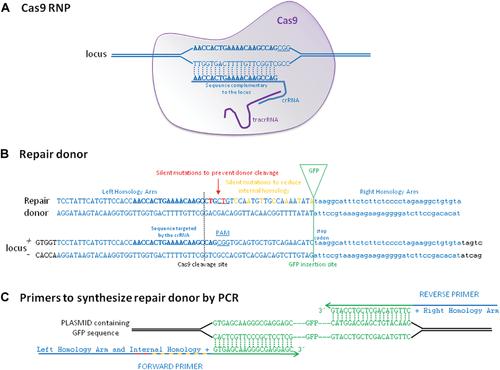{"title":"利用双链DNA供体的荧光基因工程快速标记人类蛋白质","authors":"Alexandre Paix, Dominique Rasoloson, Andrew Folkmann, Geraldine Seydoux","doi":"10.1002/cpmb.102","DOIUrl":null,"url":null,"abstract":"<p>Tagging proteins with fluorescent reporters such as green fluorescent protein (GFP) is a powerful method to determine protein localization, especially when proteins are tagged in the endogenous context to preserve native genomic regulation. However, insertion of fluorescent reporters into the genomes of mammalian cells has required the construction of plasmids containing selection markers and/or extended sequences homologous to the site of insertion (homology arms). Here we describe a streamlined protocol that eliminates all cloning steps by taking advantage of the high propensity of linear DNAs to engage in homology-directed repair of DNA breaks induced by the Cas9 RNA-guided endonuclease. The protocol uses PCR amplicons, or synthetic gene fragments, with short homology arms (30-40 bp) to insert fluorescent reporters at specific genomic locations. The linear DNAs are introduced into cells with preassembled Cas9-crRNA-tracrRNA complexes using one of two transfection procedures, nucleofection or lipofection. The protocol can be completed under a week, with efficiencies ranging from 0.5% to 20% of transfected cells depending on the locus targeted. © 2019 The Authors.</p>","PeriodicalId":10734,"journal":{"name":"Current Protocols in Molecular Biology","volume":"129 1","pages":""},"PeriodicalIF":0.0000,"publicationDate":"2019-09-19","publicationTypes":"Journal Article","fieldsOfStudy":null,"isOpenAccess":false,"openAccessPdf":"https://sci-hub-pdf.com/10.1002/cpmb.102","citationCount":"7","resultStr":"{\"title\":\"Rapid Tagging of Human Proteins with Fluorescent Reporters by Genome Engineering using Double-Stranded DNA Donors\",\"authors\":\"Alexandre Paix, Dominique Rasoloson, Andrew Folkmann, Geraldine Seydoux\",\"doi\":\"10.1002/cpmb.102\",\"DOIUrl\":null,\"url\":null,\"abstract\":\"<p>Tagging proteins with fluorescent reporters such as green fluorescent protein (GFP) is a powerful method to determine protein localization, especially when proteins are tagged in the endogenous context to preserve native genomic regulation. However, insertion of fluorescent reporters into the genomes of mammalian cells has required the construction of plasmids containing selection markers and/or extended sequences homologous to the site of insertion (homology arms). Here we describe a streamlined protocol that eliminates all cloning steps by taking advantage of the high propensity of linear DNAs to engage in homology-directed repair of DNA breaks induced by the Cas9 RNA-guided endonuclease. The protocol uses PCR amplicons, or synthetic gene fragments, with short homology arms (30-40 bp) to insert fluorescent reporters at specific genomic locations. The linear DNAs are introduced into cells with preassembled Cas9-crRNA-tracrRNA complexes using one of two transfection procedures, nucleofection or lipofection. The protocol can be completed under a week, with efficiencies ranging from 0.5% to 20% of transfected cells depending on the locus targeted. © 2019 The Authors.</p>\",\"PeriodicalId\":10734,\"journal\":{\"name\":\"Current Protocols in Molecular Biology\",\"volume\":\"129 1\",\"pages\":\"\"},\"PeriodicalIF\":0.0000,\"publicationDate\":\"2019-09-19\",\"publicationTypes\":\"Journal Article\",\"fieldsOfStudy\":null,\"isOpenAccess\":false,\"openAccessPdf\":\"https://sci-hub-pdf.com/10.1002/cpmb.102\",\"citationCount\":\"7\",\"resultStr\":null,\"platform\":\"Semanticscholar\",\"paperid\":null,\"PeriodicalName\":\"Current Protocols in Molecular Biology\",\"FirstCategoryId\":\"1085\",\"ListUrlMain\":\"https://onlinelibrary.wiley.com/doi/10.1002/cpmb.102\",\"RegionNum\":0,\"RegionCategory\":null,\"ArticlePicture\":[],\"TitleCN\":null,\"AbstractTextCN\":null,\"PMCID\":null,\"EPubDate\":\"\",\"PubModel\":\"\",\"JCR\":\"Q2\",\"JCRName\":\"Biochemistry, Genetics and Molecular Biology\",\"Score\":null,\"Total\":0}","platform":"Semanticscholar","paperid":null,"PeriodicalName":"Current Protocols in Molecular Biology","FirstCategoryId":"1085","ListUrlMain":"https://onlinelibrary.wiley.com/doi/10.1002/cpmb.102","RegionNum":0,"RegionCategory":null,"ArticlePicture":[],"TitleCN":null,"AbstractTextCN":null,"PMCID":null,"EPubDate":"","PubModel":"","JCR":"Q2","JCRName":"Biochemistry, Genetics and Molecular Biology","Score":null,"Total":0}
引用次数: 7



